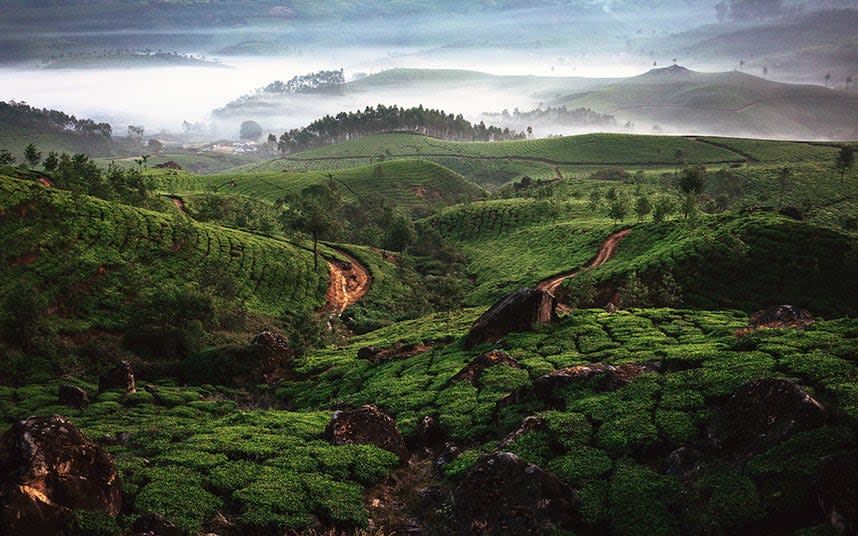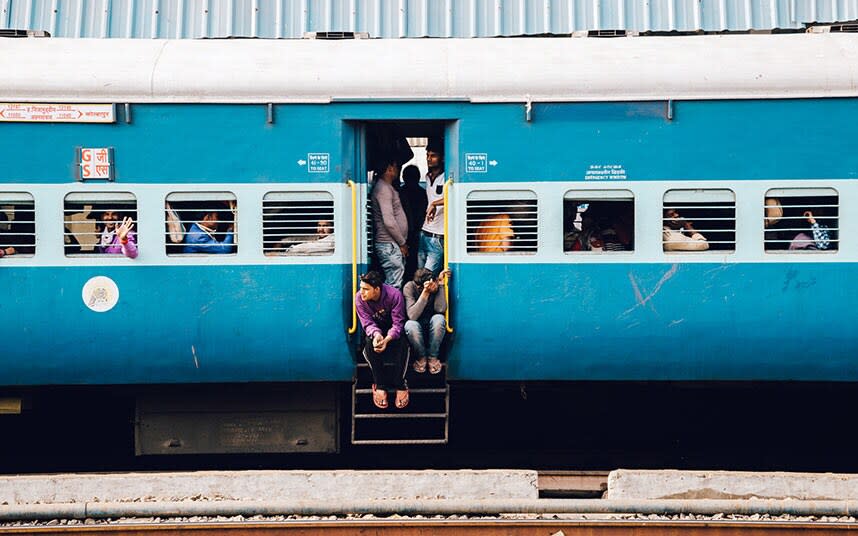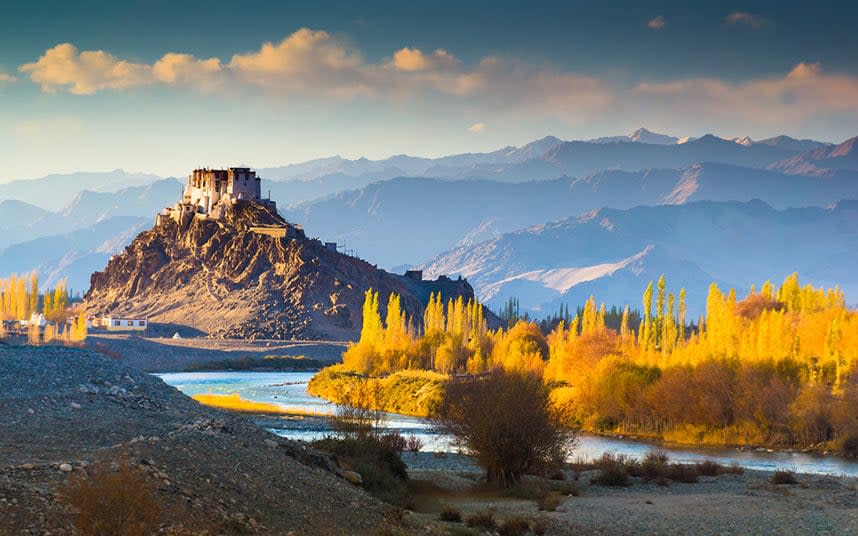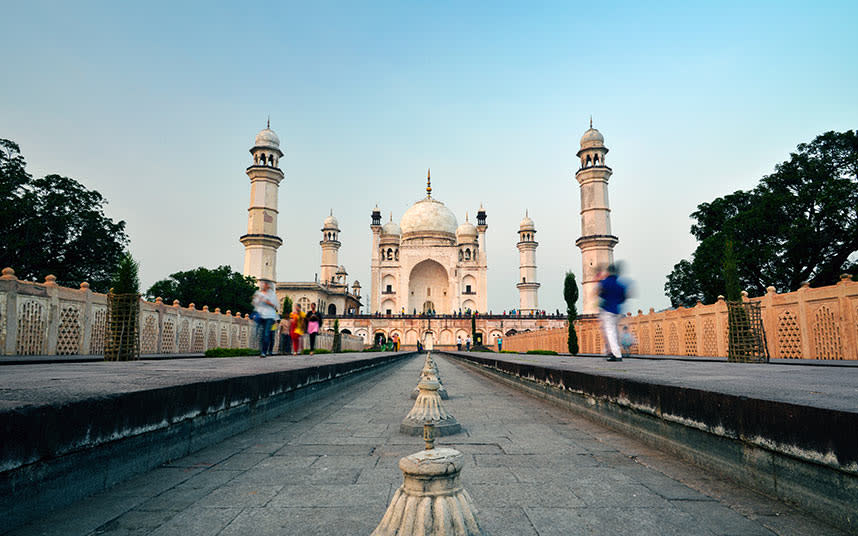‘There is more to life than increasing its speed’ – what you’ll learn on the slow train through India

When people start complaining about trains being five or six minutes late, a five-word phrase comes to mind: “Inconvenience caused is deeply regretted.”
It’s an apology my wife Clare and I have come to know well, over the 25 years or so we’ve been visiting India. Intoned like a mantra by an educated female voice, it echoes from the public address systems at Indian railway stations whenever services are running late. It’s practically on a loop when swirling winter fogs cause long delays to the vast journeys made by many of the nation’s trains.
“The Habibganj New Delhi Shatabdi Express is delayed by two hours… The Hyderabad Jaipur Express is delayed by four hours… The Firozpur Mumbai Punjab Mail is delayed by six hours.” Inconvenience caused is deeply regretted. We’ve never doubted it.
In India we travel by train whenever it’s feasible. Not generally on the plush luxury trains whose carefully planned journeys deliver the sub-continental experience with cosseting comfort and efficiency. No, we love travelling on the everyday railway network – well, actually, I love it rather more than Clare does, but we’ll come to that.
For me, travel offers few greater joys than spending a couple of days on an Indian train. Watching the sun rise scarlet through the morning mist. Lunching on the sloppy curries in flimsy foil trays which we’ve ordered ahead, then climbing up to the top bunk and dozing to the train’s slow meditative rhythm.

After another sloppy curry for dinner, we make up bunk-beds with the sheets and blankets that are provided free. We go to sleep to a soundtrack of fellow passengers’ snores and whispered conversations into mobile phones. And sometimes we wake with a start at 3am, when the train jolts to a halt at a station. We peer through the window at stray dogs running along the dimly lit platform and at sleeping figures huddled under heaps of blankets and clothes. And then we doze off again until the next scarlet sunrise.
The Indian rail network carries in excess of 23 million passengers a day. Sometimes at mainline stations – New Delhi, perhaps, or Kolkata’s Howrah or Mumbai’s Victoria Terminus (now renamed Chhatrapati Shivaji Terminus) – we’ve waited on platforms so crowded that most of those millions look like they’re catching our train.
Indians are relaxed about such crowds. Families spread out shawls and sit down to share picnics of chapatis and curries they’ve brought from home. Businessmen roll up their jackets and lie down with their heads on their briefcases for a snooze.
Cows amble from waste bin to waste bin, rooting out food, while child acrobats may be performing. Once at a station in northern India, we listened to an old man sitting on the platform and playing wispy music on a wooden flute to an audience of passengers.
People who have never travelled on Indian trains imagine they’re all like tightly packed Mumbai commuter services, with passengers perched on the roof or clinging to the sides. True, the cheaper carriages on mainline trains can be crowded, but in the air-conditioned carriages, which many Westerners opt for, seats are booked ahead and guaranteed.
Reservation charts are pasted to the sides of the carriages. “Mr Stephen” and “Mrs Clare” have figured on many a chart, complete with our ages. If you don’t give it, it will go down as “99”.
Our most ambitious journey has been a 10-day trip across India from the head of the most westerly passenger line (at Okha, 100 miles/ 160km from the Pakistan border) to the most easterly station (Ledo, in Assam, 15 miles/24km from the Burmese border).
We covered 2,300 miles (3,702km), taking in 600 stations, and could have done most of the journey on just one train, the Dwarka Express. We would have left Okha at around noon on a Friday and arrived in Assam, some way short of Ledo, on Monday morning. Sixty-seven hours on the same train: a challenge for the most passionate railophiles.

So we staggered the journey over five trains, stopping off to explore towns and cities on the way. We watched the changing Indian landscape drift hypnotically past the windows: the huts and haystacks, the processions of women in bright saris weaving their elegant way across fields, small children with enormous satchels skipping home from school.
Egrets perched on water buffaloes’ backs, smoke wreathed over the fields at “cow dust time”, the magical twilight half-hour when cows amble home from the fields. All the shimmering beauty of India which so beguiled the Raj. Train journeys like this are like time suspended – and offer time to think.
We generally travel in Second Class Air-Conditioned compartments. First Class is private, extremely comfortable and cheap by Western standards (£30 or so for a 500-mile (805km) journey). You may find yourself travelling with a retired brigadier in a thick tweed sports jacket or a “VVIP” (very, very important person). First Class, though, can insulate you from the sociability which is at the heart of Indian rail travel. Over the years, we’ve discussed Buddhism with maroon-robed monks, Hindu gurus with police officers and the bewildering pace of change in India with practically everyone.
One of our most memorable trips has been on the Kangra Valley Railway, which winds its steady way past the scenic Himalayan foothills. It covers 100 miles (160km) in 10 hours: the essence of slow travel.
It’s one of the lesser-known Indian hill railways; our fellow passengers were villagers rather than the tourists who (understandably) flock to the three best-known of the “toy train” lines – to Darjeeling, Shimla and Ooty.
If you can tear yourself away from the view, such journeys offer plenty of time for reading. Station bookstalls are stacked with P G Wodehouse, Agatha Christie and books about how to do best in business. And, if you ask, an assistant will reach for a copy of Trains at a Glance, slap it on his sleeve to get rid of the dust, and hand it over.
Trains at a Glance is the Indian rail timetable. Its most intriguing feature is the “Rail Travel Concessions chart” towards the back. Concessions, it reveals, can be claimed by “students and non-students” travelling “to render voluntary service during national calamities”, “recipients of Indian Police Medal for meritorious service”, and “artists – theatrical, musical concert, dancing, magician troupes”. Now, as I say, I love all this. Clare is more guarded, particularly about train toilets, which are not always for the faint-hearted. However clean the compartments (and they invariably are), the toilets can be a challenge. We’ll leave it at that.
No such problems, of course, on luxury trains. We’ve done a few, most memorably a preview run of the Deccan Odyssey around the state of Maharashtra. At remote stations, crowds of villagers peered through the windows of this glamorous beast. The on-board chefs worked tirelessly preparing regional dishes and never blinked when passengers asked for thin-crust pizza or Caesar salad.
And at Aurangabad we discovered the Bibi Ka Maqbara, a dead ringer for the Taj Mahal (though quieter). But I can’t recall train rides in India without hearing that phrase again: “Inconvenience caused is deeply regretted.” It evokes a memorable night many years ago, when we turned up early for a midnight train. As we waited, a train lumbered in at 11.30pm. “This is amazing,” I said to a fellow passenger. “Our train is half an hour early.” “No, no,” he replied. “This is yesterday’s train. It is 23-and-a-half hours late.”

How to do it
The eight classes of travel on Indian Railways (indianrailways.gov.in) range from the very basic to reserved First Class Air-conditioned, whose fares can be 10 times more expensive (but still low by Western standards). Rajdhani, Shatabdi and Duronto Expresses are fast and generally reliable.
Second Class AC is the preferred option of many Western passengers. Berths are grouped in fours and convert into bunk-beds for overnight journeys, curtained off from the carriage corridor. Take toilet paper, and padlocks to secure luggage.
Tickets go on sale at stations 120 days in advance and sell quickly, though tourist quotas are available. Major stations have helpful tourist bureaux and many hotels know ticket “fixers” who charge a small commission, but cut out bureaucracy.
Book in advance online at cleartrip.com. Wembley-based SD Enterprises (020 8903 3411; indiarail.co.uk) can offer expert advice, and The Man in Seat 61 (seat61.com) is an invaluable guide to the ins and outs of Indian rail travel.
Luxury trains include the Deccan Odyssey, Maharajas’ Express and the Palace on Wheels. Travel companies offering packages include Great Rail Journeys (greatrail.com), Kuoni (kuoni.co.uk), Ffestiniog Travel (ffestiniogtravel.com), Cox & Kings (coxandkings.co.uk), the Luxury Train Club (luxurytrainclub.com), the Inspiring Travel Company (inspiringtravelcompany.co.uk) and Railbookers (railbookers.co.uk).
The most magical routes
The longest haul
India’s longest train journey – the weekly Vivek Express – starts at the tea-planting town of Dibrugarh in the far North East of India, at 11.05pm on Saturdays. It arrives at Kanyakumari at the nation’s southern tip at 9.50am on the following Wednesday. This epic 82-hour journey (costing around £43 in 2AC), covers more than 2,600 miles, with 56 stops including coastal towns overlooking the Bay of Bengal. You can make the return trip on the Thursday, but probably wouldn’t want to.
Darjeeling Himalayan Railway
The “Toy Train” from Kalka to Shimla gets most attention, but two other great Indian hill-station routes are just as interesting – to Ooty (Udhagamandalam) in the South and to Darjeeling in the North. The Darjeeling Himalayan Railway, a World Heritage Site, was built to rescue Victorian plains-dwellers from sweltering summer heat. With no undue haste, it covers 55 ever-cooler miles in seven hours, sometimes weaving through village streets, and climbing to more than 7,000 feet, with panoramic views. The basic journey costs around £4 first class, but various packages are available. See www.searchdarjeeling.com.
Kangra Valley Railway
The Kangra Valley Railway is a collector’s item and a miser’s dream. Tickets for its 100-mile journey through beautiful northern Indian landscapes cost from around 50p. Set aside a day for the full journey, east from Pathankot to the town of Joginder Nagar. It takes ten hours, though most passengers are locals travelling a few stops (there are 33 all told). The line passes tea gardens and orange groves before glistening mountains loom ahead.